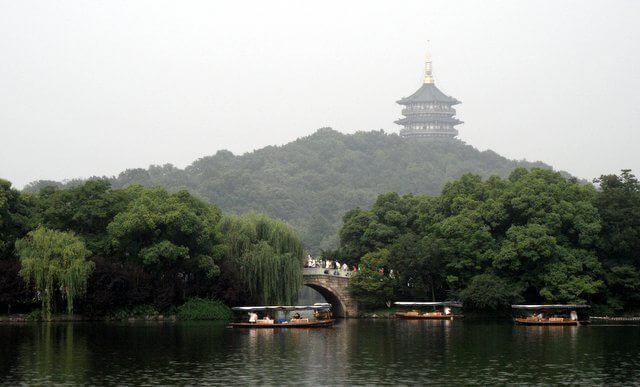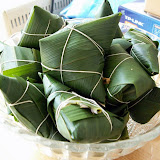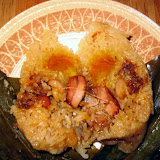
About two hours by car or 75 minutes by train from Shanghai lies the town of Hangzhou, a city described by Marco Polo as “beyond dispute the finest and the noblest in the world”. Once the largest city in the world before the Mongol sacking in 1276 it was previously a main trading port in China but its harbour silted up over time and the ships redirected to Shanghai instead. Hangzhou is now one of the most popular tourist destinations for Chinese visitors, whilst Western tourists are relatively rare there. Unwittingly we managed to visit an always busy destination during the Dragon Boat festival, known as Duanwu, which is a 3-day public holiday, so it was absolutely packed.
We didn’t see any Dragon Boats but we did partake of the other Duanwu tradition – zongzi. These are dumplings of sticky rice, wrapped around a variety of fillings such as bbq pork, pork and salted eggs, or for the sweet of tooth a red bean paste. To make them possible to carry they’re wrapped in bamboo leaves and tied with reeds, or if like us you get them from a cheap street vendor at a petrol station they come wrapped in sandwich bags.
Origins and varieties of zongzi: https://secure.wikimedia.org/wikipedia/en/wiki/Zongzi
Zongzi recipe: http://www.1on1mandarin.com/blog/zongzi-glutinous-rice-dumplings/
We also tried lovingly prepared gourmet zongzi in our hotel, but I much preferred the cheaper ones – a much tastier red-cooked pork and salted duck egg yolk filling, and no messing about with tied up leaves.
[wp_geo_map]Hangzhou’s main attraction is the freshwater West Lake. Taking about 5 hours to walk around in its entirety it is divided up by a couple of causeways and overlooked by the Leifeng Pagoda which dates back to 975 AD. We walked through the crowds but couldn’t get on any of the small boats that criss-cross the lake due to the holiday crowds. The lake has 10 famous scenes, and I think we saw as many of them as is possible at this time of year:
- Dawn on the Su Causeway in Spring
- Curved Yard and Lotus Pool in Summer
- Moon over the Peaceful Lake in Autumn
- Remnant Snow on the Bridge in Winter
- Leifeng Pagoda in the Sunset
- Two Peaks Piercing the Clouds
- Orioles Singing in the Willows
- Fish Viewing at the Flower Pond
- Three Ponds Mirroring the Moon
- Evening Bell Ringing at the Nanping Hill
After a long struggle to get a taxi we went into the town of Hangzhou to get dinner. There is an unashamedly tourist street leading away from the water which sells all sorts of stereotypical Chinese gifts such as chopsticks and silk goods, but if you walk to the end and carry on you get to the restaurant district. To the south here is a long street, lined on both sides with rows of tiny wooden sheds, each with a vendor selling a specific local dish, ranging from grilled squid, to intestines or tripe and duck tongues. Hygiene looked to be low, but the high turnover and limited range of each stall meant every dish was perfection. The most popular dish was a simple satay skewer, but pigs ears, chicken gizzards and an unidentified park of a duck were all excellent.
By way of dessert we stopped for some traditional sesame paste and got so much attention for eating random things we got a free lotus root paste thrown in. Ground black sesame has boiling water added and makes a gloopy black bowl which is eaten with a tiny plastic spoon.
The next day we spent at the Lingyin temple complex, translated as Temple of the Soul’s Retreat. Founded in 328 AD it is now one of the largest and wealthiest Buddhist temples in China. I’m not big on temples and churches but it was all very pretty and the surrounding area pleasantly green, especially the path beside the streams and pools.







